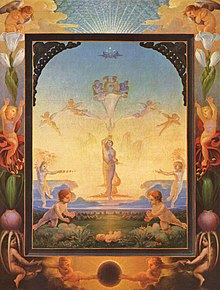
Back Romantiek AF Romantik ALS Romanticismo AN رومانسية (فن) Arabic الرومانسيه ARZ ৰমন্যাসবাদ AS Romanticismu AST Romantizm AZ رومانتیزم AZB Романтизм BA



Romanticism (also known as the Romantic movement or Romantic era) was an artistic and intellectual movement that originated in Europe towards the end of the 18th century. The purpose of the movement was to advocate for the importance of subjectivity, imagination, and appreciation of nature in society and culture during the Age of Enlightenment and the Industrial Revolution.
Romanticists rejected the social conventions of the time in favor of a moral outlook known as individualism. They argued that passion and intuition were crucial to understanding the world, and that beauty is more than merely an affair of form, but rather something that evokes a strong emotional response. With this philosophical foundation, the Romanticists elevated a number of key themes to which they were deeply committed: a reverence for nature and the supernatural, an idealization of the past as a nobler era, a fascination with the exotic and the mysterious, and a celebration of the heroic and the sublime.
The Romanticist movement had a particular fondness for the Middle Ages, which to them represented an era of chivalry, heroism, and a more organic relationship between humans and their environment. This idealization contrasted sharply with the values of their contemporary industrial society, which they considered alienating for its economic materialism and environmental degradation. The movement's illustration of the Middle Ages was a key theme in debates, with allegations that Romanticist portrayals often overlooked the downsides of medieval life.
The consensus is that Romanticism peaked from 1800 until 1850. However, a "Late Romantic" period and "Neoromantic" revivals are also discussed. These extensions of the movement are characterized by a resistance to the increasingly experimental and abstract forms that culminated in modern art, and the deconstruction of traditional tonal harmony in music. They continued the Romantic ideal, stressing depth of emotion in art and music while showcasing technical mastery in a mature Romantic style. By the time of World War I though, the cultural and artistic climate had changed to such a degree that Romanticism essentially dispersed into subsequent movements. The final Late Romanticist figures to maintain the Romantic ideals died in the 1940s. Though they were still widely respected, they were seen as anachronisms at that point.
Romanticism was a complex movement, with a variety of viewpoints that permeated Western civilization across the globe. The movement and its opposing ideologies mutually shaped each other as time went on. After its end, Romantic thought and art exerted a sweeping influence on art and music, speculative fiction, philosophy, politics, and environmentalism that has endured into the present day.
The movement is the reference for the modern notion of "romanticization" and the act of "romanticizing" something.